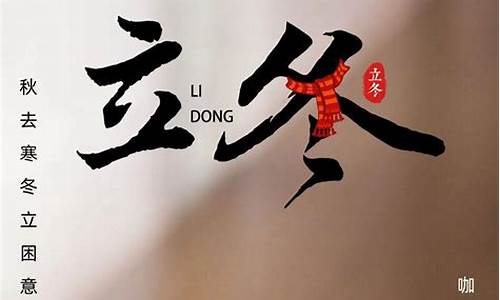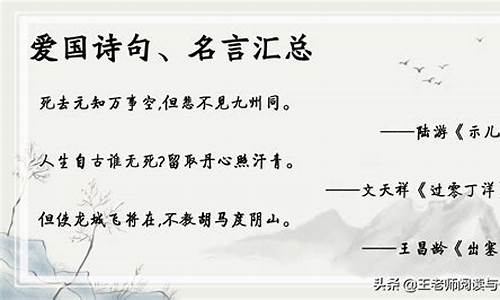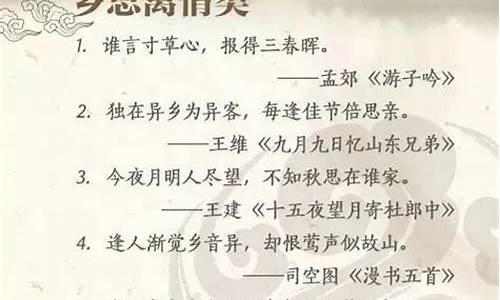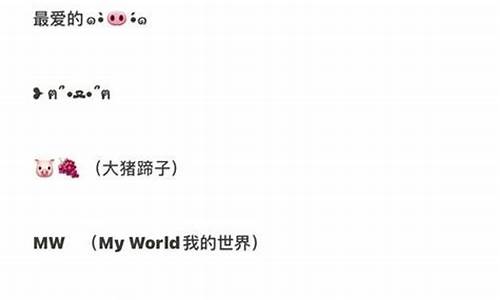您现在的位置是: 首页 > 文案大全 文案大全
英语句子的结构有哪些?_英语的句子结构有几种形式和类型
tamoadmin 2024-08-12 人已围观
简介1.英语句型有哪几种类型2.题目 英语的句子结构有哪几种3.英语句子的种类有哪些?有例句吗?4.英语句型结构是什么?英语句子结构有五种(主谓,主谓宾,主系表,主谓宾宾和主谓宾宾补) 主谓:I study. 主谓宾:I like banana. 主系表:I am a student. 主谓双宾:I give a pencil to him. 主谓复合宾语:I make him hy. 1. 主语+谓
1.英语句型有哪几种类型
2.题目 英语的句子结构有哪几种
3.英语句子的种类有哪些?有例句吗?
4.英语句型结构是什么?
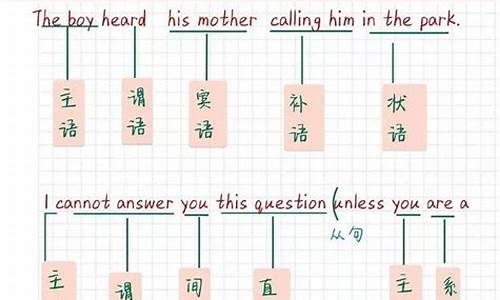
英语句子结构有五种(主谓,主谓宾,主系表,主谓宾宾和主谓宾宾补)
主谓:I study.
主谓宾:I like banana.
主系表:I am a student.
主谓双宾:I give a pencil to him.
主谓复合宾语:I make him hy.
1. 主语+谓语(不及物动词) [S + V]
如:The children are playing hily.
孩子们正在高兴地玩。
2. 主语+谓语(及物动词)+宾语 [S+V+O]
如:The Greens enjoy living in China.
格林一家喜欢住在中国。
3. 主语+谓语+表语 [S+V+P]
该句型谓语动词为连系动词。常见的系动词有:be(是); get(变得), become(成为), turn(变得), look(看起来), feel(感到), smell(闻起来), taste(尝起来), sound(听起来), seem(似乎) 等。如:
① He became a famous doctor.
他成为了一名著名的医生。
② The le pie tastes really delicious.
苹果派吃起来真是好吃。
4. 主语+谓语+间接宾语+直接宾语 [S+V+InO+DO]
这种句型中的及物动词后跟双宾语,既指人的间接宾语和指物的直接宾语。也可以把间接宾语放在直接宾语之后,但要加介词for或to。如:
① My aunt bought me a computer. = My aunt bought a computer for me. 我阿姨买给我一台电脑。
② I passed him the salt. = I passed the salt to him.
我把盐递给他。
5. 主语+谓语+宾语+宾语补足语 [S+V+O+OC]
如:We must keep our school clean.
我们必须保持我们的学校清洁。
1. Subject (主语) + Verb (谓语)
这种句型中的动词大多是不及物动词,这些动词常见的有:ear, apologize,arrive, come, die, disear, exist, fall, hen, rise,等等。如:
The students work very hard.学生们学习很努力。
She apologized to me again. 她再次向我道歉。
The accident hened yesterday evening.事故是昨天晚上发生的。
2. Subject (主语) + Link. V(系动词) + Predicate(表语)
这种句型中的系动词一般可分为下列两类:
(1)表示状态的连系动词。这些词有:be, look, seem, ear, smell, taste, sound, keep, remain, 等等。如:
Several players lay flat on the playground.几个队员平躺在操场上。
We should remain modest and prudent any time.我们在任何时候都应该保持谦虚谨慎。
This kind of food tastes terrible.这种食物吃起来很糟糕。
The picture looks more beautiful at a certain distance.这幅画在一定的距离看更漂亮一些。
(2)表示转变或结果的系动词。这些词有:become, get, grow, turn, go, come, prove,等等。如:
Spring comes. It is getting warmer and warmer.春天到了,天气变得越来越暖和。
Don't he the food. It has gone bad.不要吃那种食物,已经变质了。
The facts prove true.事实证明是正确的。
3. Subject(主语) + Verb (谓语) + Object (宾语)
这种句型中的动词应为及物动词或者可以后接宾语的动词短语。同时,句子中有时含有与宾语有关的状语。作宾语的成分常是:名词、代词、动词不定式、动名词或从句。如:
You can put the books in your bag.你可以把书放在书包里。
Farmers in our area grow lots of vegetables.我们这里的农民种很多种蔬菜。
She lost the chance to make her earance on the stage.她失去了在舞台上露面的机会。
I prefer to make web pages.我更喜欢做网页。
4. Subject(主语)+Verb(谓语)+ Indirect object(间接宾语)+Direct object (直接宾语)
这种句型中作间接宾语的常常指“人”,直接宾语常常指“物”。如:
Yesterday her father bought her a bicycle as a birthday present.昨天她父亲给她买了一辆自行车作为生日礼物。
The old man is telling the children stories in the Long March.老人正在给孩子们讲长征中的故事。
这种句型还可转换为其他两种句型:1)动词 + 宾语 + for sb.; 2)动词 + 宾语+to sb.。如:
Please show me your picture. /Please show your picture to me.
请把你的画给我看一下。
I'll offer you a good chance as long as you don’t lose heart.
—I'll offer a good chance for you as long as you don't lose heart.
只要你不失去信心,我会给你提供机会的。
5. Subject(主语)+Verb (动词)+Object (宾语)+Complement(补语)
这种句型中的宾语+ 补语可统称为“复合宾语”。担任补语的常常是名词、形容词、副词、介词短语、分词、动词不定式等。如:
Keep the children quiet, please. 请让孩子们安静下来。
He painted the wall white. 他把墙漆成白色。
We found him an honest person.我们发现他是一个诚实的人。
His mother told him not to play on the street.他母亲告诉他不要在街上玩。
注意:动词he, make, let, see, hear, notice, feel, observe, watch等后面所接的动词不定式作宾补时,不带to。如:
The boss made him do the work all day.老板让他整天做那项工作。
1. 主语+ 不及物动词
例:It is raining heily. /My tooth aches.
2. 主语 + 及物动词 + 宾语
例:They enjoy the play. /I met John in the street yesterday.
3. 主语 + 系动词 + 表语
例:He is out. /Jenny is fine. /It looks like rain, soon.
4 主语 + 及物动词 + 双宾语
例:He bought her a watch. /The sun gives us light.
注意:双宾语一个指人(即间接宾语),另一个指物(即直接宾语)。一般间接宾语位于直接宾语的前面,有时它们也可交换位置,这是需要在间接宾语的前面加上介词to 或for 。
常见的双宾语结构:bring sb. sth (bring sth to sb). give sb. sth (give sth to sb.)
hand sb. sth (hand sth to sb.) lee sb. sth (lee sth.to sb)
lend sb. sth (lend sth to sb) pass sb sth (pass sth to sb)
return sb. sth (return sth to sb) send sb sth (send sth to sb)
show sb sth (show sth. to sb.) tell sb sth (tell sth to sb )
write sb sth (write sth to sb ) buy sb sth (buy sth for sb )
do sb sth (do sth for sb ) get sb sth (get sth for sb )
make sb. sth (make sth for sb) pay sb. sth (pay sth for sb)
sing sb sth (sing sth for sb )
5. 主语 + 及物动词 + 宾语 + 补足语
例:She found him a very clever student. / I make it a rule to get up early in the morning.
(S+V+P)
The bike is new. /The map is on the wall.
第二种 主语+不及物动词 (S+V)
He swims.
第三种 主语+及物动词+宾语 (S+V+O)
Children often sing this song.
第四种 主语+及物动词+间接宾语+直接宾语 (S+V+IO+DO)
She showed her friends all her pictures.
英语句型有哪几种类型
一、陈述句:是用来陈述一件事情或表示一种看法,可分为肯定句和否定句两种形式。
1、谓语动词是be动词,助动词he, has, will,情态动词can等时,只要直接在这些词后面加not就构成否定形式。
eg. Lily has already read this new book. (改为否定句)
Lily ______ ______ this new book ________.
2、谓语动词是行为动词而又没有助动词或情态动词时,必须在谓语动词前加助动词,一般现在时加助动词do ,第三人称单数加does,一般过去时加did,再和not构成否定结构。必须指出的是:don't, doesn't, didn't后都用动词原形。
eg.1)Jill has lunch at school every day. (改为否定句)
Jill _____ _____ lunch at school every day.
2)The children had a good time at the party. (改为否定句)
The children ______ _____ a good time at the party.
3)Rose didn't drink any milk this morning.(改为肯定句)
Rose ______ ______ milk this morning.
二、疑问句:是用来提出问题的句子。
A.一般疑问句:以be动词, he /has/do等助动词、can/may等情态动词开头,以yes或no来回答的问句。
它的基本结构是:Be/He /Has/Did等助动词(包括情态动词)+主语+谓语(包括表语)+┄?回答常用简略回答。
1、谓语动词是be动词、助动词、情态动词时,只要直接把这些词置于句首,句末改成问号。
eg. There's something wrong with his bike.(改成疑问句)
______ _____ _______ wrong with his bike?
2、谓语动词是行为动词时,必须在句首加上助动词Do、Does(三单)、Did(过去式)加上这些助动词后,句子中谓语动词必须用原形。
eg. 1)Edison built a science lab himself when he was ten. (改成疑问句)
______ Edison ______ a science lab himself when he was ten?
2)Those Japanese like Chinese food.(改成疑问句)
______ those Japanese ________ Chinese food?
注意:在把肯定句改成否定句或一般疑问句的时候,要注意句中是否有already、some、something、somebody等词,如果有也必须进行改变,already要改成yet,some、something、somebody等分别改成any、anything、anybody等。另外,在改成否定句的时候注意把too改成either,both改成neither,all改成none等.在改成一般疑问句的时候,常常把第一人称I、we改成第二人称you。
B.特殊疑问句:以疑问代词或疑问副词开头,提出疑问的句子。
它的基本结构是:特殊疑问词+一般疑问句语序。但是如果疑问词在句子中作主语或作主语的定语,就用特殊疑问词+陈述句语序。常用的疑问词有:what, who(whom), whose,which,when,where,how,why等,回答时针对问句中的代词和副词来回答,不用yes或no来回答。
1)对指物名词或谓语动词提出疑问,疑问词用what
①The twins were making a kite when their mother came in. (划线提问)
______ _____ the twins _____ when their mother came in?
②Mrs Turner asked her son to buy some eggs for supper. (划线提问)
_______ ______ Mrs Turner ask her son ______ _______?
2)对名词前定语提出疑问,疑问词应用which,而且必须和名词连用。
I'm going to take the shirt on the right.(划线提问)
______ _____ are you going to take?
3)对指人名词或代词提问用who,作宾语时提问用whom。
eg.Li Ping,they,his father
4)对物主代词和名词所有格提问用whose。
eg. Li Ping's coat→Whose coat my father→Whose father
5)对具体时间提出疑问,如 in the morning,last Sunday等,疑问词用when;对具体几点钟提问,疑问词应用what time。
6)对具体地点提出疑问,疑问词应用where。
The pupils are hing a picnic at the foot of the hill. (划线提问)
_____ _____ the pupils hing a picnic?
7)对表原因的从句提问,常见的有because引导的从句,疑问词应用why。
Xiao Cheng didn't go to the farm with us because he was ill. (划线提问)
_______ _____ Xiao Cheng go to the farm with us?
8)对方式或程度等提出疑问,用疑问词How。
eg. go by bike like very much
9)对数量提出疑问,疑问词为How many,要注意how many必须跟名词的复数形式。
eg. two hundred sheep→How many sheep
10)对价格提出疑问,疑问词用How much。
eg. I paid fifty yuan for the sweater.
______ ______ did you pay for the sweater?
11)对时间长度提出疑问,疑问词应用How long。
eg. I've worked in that factory for two years. (划线提问)96中考题
______ _____ _______ you worked in that factory?
12)对时间频率,如 once a year, twice a week等提问,疑问词用How often。
13)对具体次数,如 once, twice, three times等提问,疑问词用How many times。
eg. ______ did he call you the day before yesterday?Twice. 96中考题
A.What time B.How many times C.How much D.How long
14)对in+一段时间提问,疑问词一般用How soon。
eg. Jane and her brother will finish the work in two hours. (划线提问)
_____ _____ _____ Jane and her brother finish the work?
15)对距离提出疑问,疑问词用How far。
eg. It's about two kilometres from here to the country.(划线提问)
______ _____ _____ _____ from here to the country?
16)另外,对日期、星期、天气等提出疑问,则分别用
What's the date?
What day is it ? 如果是过去时间,就用was代替is。
What's the weather like?
练习题
1)She does exercises at home in the evening.(改成否定句、一般疑问句)
She ______ ______ exercises at home in the evening.
______ she _____ exercises at home in the evening?
2)He said something important at the meeting.(改为否定句,一般疑问句)
He _____ ______ ______ important at the meeting.
______ he ______ ______ important at the meeting?
3)It'll take them three weeks to finish the work.(划线提问)
______ ______ _______ it take them to finish the work?
4)I he to wash all the plates and things after meals.(划线提问)
_____ _____ you he to wash all the plates and things?
5)The woman in the red coat is her mother.(划线提问)
______ ______ is her mother?
6)Li Ping spent twenty yuan on the dictionary.(划线提问)
_____ ____ ____ Li Ping _____ on the dictionary?
思考题
1)The worker's visited the factory already.(改成否定句、一般疑问句)
The worker _____ _____ the factory ______.
____ the worker ___ the factory __?
2)Both of his parents are workers.(改成否定句)
___ of his parents ______ a worker.
3)He went to the park with his sister.(划线提问)
_____ ____ ____ he go to the park?
4)We really enjoyed working on the farm.(划线提问)
What _____ you really enjoy ______?
5)She writes to her parents once a week.(划线提问)
_______ ______ ______ she write to her parents?
6)Our P.E teacher has been at this school since he came.(划线提问)
______ ______ ______ our P.E teacher been at this school?
一、陈述句:是用来陈述一件事情或表示一种看法,可分为肯定句和否定句两种形式。
1、谓语动词是be动词,助动词he, has, will,情态动词can等时,只要直接在这些词后面加not就构成否定形式。
eg. Lily has already read this new book. (改为否定句)
Lily ______ ______ this new book ________.
2、谓语动词是行为动词而又没有助动词或情态动词时,必须在谓语动词前加助动词,一般现在时加助动词do ,第三人称单数加does,一般过去时加did,再和not构成否定结构。必须指出的是:don't, doesn't, didn't后都用动词原形。
eg.1)Jill has lunch at school every day. (改为否定句)
Jill _____ _____ lunch at school every day.
2)The children had a good time at the party. (改为否定句)
The children ______ _____ a good time at the party.
3)Rose didn't drink any milk this morning.(改为肯定句)
Rose ______ ______ milk this morning.
二、疑问句:是用来提出问题的句子。
A.一般疑问句:以be动词, he /has/do等助动词、can/may等情态动词开头,以yes或no来回答的问句。
它的基本结构是:Be/He /Has/Did等助动词(包括情态动词)+主语+谓语(包括表语)+┄?回答常用简略回答。
1、谓语动词是be动词、助动词、情态动词时,只要直接把这些词置于句首,句末改成问号。
eg. There's something wrong with his bike.(改成疑问句)
______ _____ _______ wrong with his bike?
2、谓语动词是行为动词时,必须在句首加上助动词Do、Does(三单)、Did(过去式)加上这些助动词后,句子中谓语动词必须用原形。
eg. 1)Edison built a science lab himself when he was ten. (改成疑问句)
______ Edison ______ a science lab himself when he was ten?
2)Those Japanese like Chinese food.(改成疑问句)
______ those Japanese ________ Chinese food?
注意:在把肯定句改成否定句或一般疑问句的时候,要注意句中是否有already、some、something、somebody等词,如果有也必须进行改变,already要改成yet,some、something、somebody等分别改成any、anything、anybody等。另外,在改成否定句的时候注意把too改成either,both改成neither,all改成none等.在改成一般疑问句的时候,常常把第一人称I、we改成第二人称you。
B.特殊疑问句:以疑问代词或疑问副词开头,提出疑问的句子。
它的基本结构是:特殊疑问词+一般疑问句语序。但是如果疑问词在句子中作主语或作主语的定语,就用特殊疑问词+陈述句语序。常用的疑问词有:what, who(whom), whose,which,when,where,how,why等,回答时针对问句中的代词和副词来回答,不用yes或no来回答。
1)对指物名词或谓语动词提出疑问,疑问词用what
①The twins were making a kite when their mother came in. (划线提问)
______ _____ the twins _____ when their mother came in?
②Mrs Turner asked her son to buy some eggs for supper. (划线提问)
_______ ______ Mrs Turner ask her son ______ _______?
2)对名词前定语提出疑问,疑问词应用which,而且必须和名词连用。
I'm going to take the shirt on the right.(划线提问)
______ _____ are you going to take?
3)对指人名词或代词提问用who,作宾语时提问用whom。
eg.Li Ping,they,his father
4)对物主代词和名词所有格提问用whose。
eg. Li Ping's coat→Whose coat my father→Whose father
5)对具体时间提出疑问,如 in the morning,last Sunday等,疑问词用when;对具体几点钟提问,疑问词应用what time。
6)对具体地点提出疑问,疑问词应用where。
The pupils are hing a picnic at the foot of the hill. (划线提问)
_____ _____ the pupils hing a picnic?
7)对表原因的从句提问,常见的有because引导的从句,疑问词应用why。
Xiao Cheng didn't go to the farm with us because he was ill. (划线提问)
_______ _____ Xiao Cheng go to the farm with us?
8)对方式或程度等提出疑问,用疑问词How。
eg. go by bike like very much
9)对数量提出疑问,疑问词为How many,要注意how many必须跟名词的复数形式。
eg. two hundred sheep→How many sheep
10)对价格提出疑问,疑问词用How much。
eg. I paid fifty yuan for the sweater.
______ ______ did you pay for the sweater?
11)对时间长度提出疑问,疑问词应用How long。
eg. I've worked in that factory for two years. (划线提问)96中考题
______ _____ _______ you worked in that factory?
12)对时间频率,如 once a year, twice a week等提问,疑问词用How often。
13)对具体次数,如 once, twice, three times等提问,疑问词用How many times。
eg. ______ did he call you the day before yesterday?Twice. 96中考题
A.What time B.How many times C.How much D.How long
14)对in+一段时间提问,疑问词一般用How soon。
eg. Jane and her brother will finish the work in two hours. (划线提问)
_____ _____ _____ Jane and her brother finish the work?
15)对距离提出疑问,疑问词用How far。
eg. It's about two kilometres from here to the country.(划线提问)
______ _____ _____ _____ from here to the country?
16)另外,对日期、星期、天气等提出疑问,则分别用
What's the date?
What day is it ? 如果是过去时间,就用was代替is。
What's the weather like?
练习题
1)She does exercises at home in the evening.(改成否定句、一般疑问句)
She ______ ______ exercises at home in the evening.
______ she _____ exercises at home in the evening?
2)He said something important at the meeting.(改为否定句,一般疑问句)
He _____ ______ ______ important at the meeting.
______ he ______ ______ important at the meeting?
3)It'll take them three weeks to finish the work.(划线提问)
______ ______ _______ it take them to finish the work?
4)I he to wash all the plates and things after meals.(划线提问)
_____ _____ you he to wash all the plates and things?
5)The woman in the red coat is her mother.(划线提问)
______ ______ is her mother?
6)Li Ping spent twenty yuan on the dictionary.(划线提问)
_____ ____ ____ Li Ping _____ on the dictionary?
思考题
1)The worker's visited the factory already.(改成否定句、一般疑问句)
The worker _____ _____ the factory ______.
____ the worker ___ the factory __?
2)Both of his parents are workers.(改成否定句)
___ of his parents ______ a worker.
3)He went to the park with his sister.(划线提问)
_____ ____ ____ he go to the park?
4)We really enjoyed working on the farm.(划线提问)
What _____ you really enjoy ______?
5)She writes to her parents once a week.(划线提问)
_______ ______ ______ she write to her parents?
6)Our P.E teacher has been at this school since he came.(划线提问)
______ ______ ______ our P.E teacher been at this school?
句型转换题是中考常见题型,它主要用来考查大家对句子结构的构成、变化的掌握及在行文中的运用等,类型繁多。现以近两年中考题为例,分类介绍如下:
[第一类] 改成否定句
英语中有关否定的结构各不相同,除动词部分构成的否定外,还有名词、代词的否定、部分否定、否定转移、以及一些表示否定意义的短语或句型等。
一、含有连系动词、情态动词等助动词的句子改为否定句时,在连系动词、情态动词等的后面加not就行了。如:(划线部分为正确答案,下同。)
1. He was late for school yesterday. (2005黑龙江省泰州市)
He wasn’t late for school yesterday.
2. The students of No.2 Middle School he gone for a picnic already. (2004新疆)
The students of No.2 Middle School hen’t gone for a picnic yet.
二、祈使句变否定句一般在其前加don’t。如:
3. Open the window. (2005江苏省)
Don’t open the window.
三、实义动词的否定式是在实义动词前加don’t, doesn’t, didn’t等。如:
4. She does the housework every day. (2005黑龙江省哈尔滨市)
She doesn’t do the housework every day.
5. He returned the book to the library this morning. (2004重庆市)
He didn’t return the book to the library this morning.
注意:变否定句时须注意某些词语的变化,如some改为any, something改为anything, already改为yet, both改为neither, all改为none等。又如:
6. Both of them are my best friends. (2004甘肃省兰州市)
Neither of them is my best friend.
[第二类] 改为疑问句
可分为一般疑问句、选择疑问句和反意疑问句。
一、变一般疑问句时,含有连系动词、情态动词的句子,只需将它们移至句首,第一个字母变为大写,句尾改为问号即可。含有实义动词的句子,在实义动词前加do, does, did等。变化过程中也要注意某些词语和人称的变化。如:
7. There’s something to eat in the cupboard.(2005贵州省贵阳市)
Is there anything to eat in the cupboard?
8. Kate does morning exercises every day. (2004山东省济南市)
Does Kate do morning exercises every day?
9. Ann returned the book to the library yesterday. (2005四川省成都市)
Did Ann return the book to the library yesterday?
二、变选择疑问句时,如果该句是一般疑问句,则在后面直接加“or+另一选择部分”就行了;若是陈述句,则要先变成一般疑问句。如:
10. John is an American. (用a Canadian改为选择疑问句)(2004新疆)
Is John an American or a Canadian?
三、变反意疑问句时,要注意“前肯后否”和“前否后肯”,还要注意一些特殊形式的反意疑问句。如:
11. She has hardly had anything this morning, has she?(2005山东省泰安市)
12. You will meet your friends at the railway station, won’t you?(2004重庆)
13. She had nothing for breakfast, did she?(2005青海)
14. There was no time for the twins to go shopping, was there?(2004黑龙江省哈尔滨市)
题目 英语的句子结构有哪几种
英语句子里面的几种类型:
简单句(simple sentences)
并列句(compound)
主从复合句(complex)
并列复合句(compound-complex)
一简单句
定义:简单句就是只含有一个主谓结构并且句子各成分都只由单词或短语构成的独立句子或分句。在简单句中主语和谓语是句子的主干,是句子的核心。
二、并列句
定义:由并列连词把两个或两个以上的简单句连在一起的句子叫并列句。不同的并列连词表示并列分句之间的不同关系。
三、主从复合句
定义:主从复合句由一个主句和一个或一个以上的从句构成。主句为句子的主体,从句只用作句子的一个次要成分,不能独立成为一个句子。
名词性从句?(主语从句,宾语从句,表语从句和同位语从句)
定语从句
状语从句(时间状语,地点状语,条件状语,让步状语,原因状语等。)
四、并列复合句
定义:并列复合句必须由两个或更多的独立主句,加上一个或更多的从句构成。
可以理解为是并列句和复合句的结合体。
英语句子的种类有哪些?有例句吗?
一、英语语句基本结构分析:
(一)主谓宾结构:
1、主语:可以作主语的成分有名词(如boy),主格代词(如you),数词,动词不定式,动名词等.主语一般
在句首.注意名词单数形式常和冠词不分家!
eg: The boy comes from America.
He made a speech.
2、谓语:谓语由动词构成,是英语时态、语态变化的主角,一般在主语之后.谓语可以是不及物动词(vi.)没
有宾语,形成主谓结构,
eg:We come.
Many changes took place in my home town.
注(以下这些词是不及物动词:表发生、出现的,如:take place, ear, hen, break out; 表来、去,如:com
e, go 等)
3、宾语:宾语位于及物动词之后,一般同主语构成一样,不同的是构成宾语的代词必须是‘代词宾格’,如:me,
him,them等.除了代词宾格可以作宾语外,名词,动名词,不定式等可以作宾语.
eg:I will do it tomorrow.
The boy needs a pen.
(二)主系表结构:
1、主语:同‘主谓宾’结构.
2、谓语:联系动词(Link verb):be动词(am,is,are,was,were,he been);其他联系动词如:become成为,turn变
成,go变和感官动词如:feel, touch, hear, see等.其特点是联系动词与其后的表语没有动宾关系,表语多为形容词
或副词,既,不可能是宾语.
3、表语:说明主语的状态、性质、等.可为形容词、副词、名词、代词、不定式、分词.(1)当联系动词不是
be,而其后是名词和代词时,多表达‘转变为’之意,注意与动宾关系的区别.
eg: He became a teacher at last.
His face turned red.
(2)感官动词多可用作联系动词
eg: He looks well.他面色好.
It sounds nice.这个听起来不错.
I feel good.我感觉好.
The egg smells bad.这个鸡蛋难闻.
例:Tom is a boy.(Tom是个男孩)主语为Tom,系词为be动词的第三人称单数is,表语为a boy
(三)There be 结构:
There be 表示‘存在有’.这里的there没有实际意义,不可与副词‘there那里’混淆.
此结构后跟名词,表示‘(存在)有某事物’
试比较:There is a boy there.(那儿有一个男孩.)/前一个there无实意,后一个there为副词‘那里’.
二、定语:定语是对名词或代词起修饰、限定作用的词、短语或句子,汉语中常用‘……的’表示.
定语通常位于被修饰的成分前.若修饰some,any,every,no构成的复合不定代词时,(如:something、nothing);
或不定式、分词短语作定语、从句作定语时,则定语通常置后.副词用作定语时须放在名词之后.
(一)形容词作定语:
The little boy needs a blue pen.小男孩需要一支蓝色的钢笔.
(二)数词作定语相当于形容词:
Two boys need two pens.两个男孩需要两支钢笔.
(三)形容词性物主代词或名词所有格作定语:
His boy needs Tom's pen.他的男孩需要Tom的钢笔.
There are two boys of Toms there.那儿有Tom家的两个男孩.
(四)介词短语作定语:
The boy in the classroom needs a pen of yours.教室里的男孩需要你的一支钢笔.
The boy in blue is Tom.穿兰色衣服的孩子是汤姆.
There are two boys of 9,and three of 10.有两个9岁的,三个10岁的男孩.
(五)名词作定语:
The boy needs a ball pen.男孩需要一支圆珠笔.
副词作定语:
The boy there needs a pen.那儿的男孩需要一支钢笔.
不定式作定语:
The boy to write this letter needs a pen.写这封信的男孩需要一支钢笔.
(六)分词(短语)作定语:
The smiling boy needs a pen bought by his mother.那个微笑的男孩需要一支他妈妈买的钢笔.
(七)定语从句:
The boy who is reading needs a pen.那个在阅读的男孩需要一支钢笔.
三、状语:状语修饰动词、形容词、副词或全句,说明方式、因果、条件、时间、地点、让步、方向、程度、目
的等
状语在句子中的位置很灵活,常见情况为:通常在句子基本结构之后,强调时放在句首;修饰形容词或副词时,
通常位于被修饰的词之前;表示时间、地点、目的的状语一般位于句子两头,强调时放在句首,地点状语一般须
在时间状语之前;一些表示不确定时间(如:often)或程度(如:almost)的副词状语通常位于be动词、助动
词、情态动词之后,动词之前.
有时状语在句中的某个位置会引起歧义,应注意,如:The boy calls the girl in the classroom.一般理解成‘男孩喊教
室里的女孩‘(此时in the classroom为girl的定语),也可以理解为‘男孩在教室里喊女孩’(此时in the classroom为地
点状语),最好写作‘In the classroom,the boy calls the girl.'
(一)副词(短语)作状语:
The boy needs a pen very much.男孩非常需要一支钢笔.(程度状语)
The boy needs very much the pen bought by his mother.男孩非常需要他母亲买的那支钢笔.(宾语较长则状语前
置)
The boy needs a pen now./Now,the boy needs a pen./The boy,now,needs a pen./男孩现在需要一支钢笔.(时间状
语)
(二)介词短语作状语:
In the classroom,the boy needs a pen.在教室里,男孩需要一支钢笔.(地点状语)
Before his mother,Tom is always a boy.在母亲面前,汤姆总是一个男孩子.(条件状语)
On Sundays,there is no student in the classroom.星期天,教室里没有学生.(时间状语)
(三)分词(短语)作状语:
He sits there,asking for a pen.他坐在那儿要一支笔.(表示伴随状态)
Hing to finish his homework,the boy needs a pen.因为不得不完成作业,男孩需要一支笔.(原因状语)
(四)不定式作状语:
The boy needs a pen to do his homework.男孩需要一支笔写家庭作业.(目的状语)
(五)名词作状语:
Come this way!走这条路!(方向状语)
(六)状语从句:
时间状语从句,地点状语从句,原因状语从句,结果状语从句,目的状语从句,比较状语从句,让步状语从句,
条件状语从句
四、直接宾语和间接宾语:
(一)特殊的同源宾语现象: fight a fight , dream a dream , etc.
(二)有些及物动词可以有两个宾语,如:give给,pass递,bring带,show显示.这两个宾语通常一个指人,为
间接宾语;一个指物,为直接宾语.间接宾语一般位于直接宾语之前.
一般的顺序为:动词 + 间接宾语 + 直接宾语.
eg:Give me a cup of tea,please.
强调间接宾语顺序为:动词 + 直接宾语 + to + 间接宾语.eg:Show this house to Mr.Smith.Mr.
五、宾语补足语:位于宾语之后对宾语作出说明的成分.宾语与其补足语有逻辑上的主谓关系,它们一起构成复
合宾语.
(一)名词/代词宾格 + 名词
The war made him a soldier.战争使他成为一名战士.
(二)名词/代词宾格 + 形容词
New methods make the job easy.新方法使这项工作变得轻松.
(三)名词/代词宾格 + 介词短语
I often find him at work.我经常发现他在工作.
(四)名词/代词宾格 + 动词不定式
The teacher ask the students to close the windows.老师让学生们关上窗户.
(五)名词/代词宾格 + 分词
I saw a cat running acrothe road.我看见一只猫跑过了马路.
六、同位语:同位语是在名词或代词之后并列名词或代词对前者加以说明的成分,近乎于后置定语.如:
We students should study hard. (students是we的同位语,都是指同一批‘学生’)
We all are students. (all是we的同位语,都指同样的‘我们’)
七、独立成分:有时句子中会有一些与句子没有语法联系的成分,称为句子独立成分(注意:区别于分词独立结
构).
感叹词:oh,hello,aha,ah,等.肯定词yes否定词no称呼语:称呼人的用语.插入语:一些句中插入的 I think , I belie
ve,等.
如: The story,I think,has never come to the end./我相信,这个故事还远没结束.
情态词,表示说话人的语气(多作为修饰全句的状语):perhaps也许,maybe大概,acturely实际上,certainly当然,
等.
八、分词独立结构:分词作状语时其逻辑主语与句子的主语一致! 否则应有自己的逻辑主语,构成分词独立结
构.
例:错句:Studying hard,your score will go up.
正确:(1) Studying hard,you can make your score go up. 或 (2)If you study hard,your score will go up.
解析:错句中分词studying没有自带逻辑主语,则其逻辑主语就是句子的主语,既your score . 显然做study的应是
人,不应是your score(分数). 正确句(1)更正了句子的主语,使其与分词逻辑主语一致( 同为you );正确句(2)则使
用条件分句带出study的主语,(不过已经不是分词结构了).
分词独立结构常省略being,hing been.不过‘There being...’的场合不能省略.
如:
Game (being) over,he went home.
He stands there,book (being) in hand.
独立结构还可用with、without引导,作状语或定语.这种结构不但可以用分词,还可以用不定式、形容词、介词
短语、副词或名词等.
如:
With nothing to do,he fell asleep soon.无事可做,他很快就睡着了.
The teacher came in,with glasses on his nose.老师进来了,戴着一付眼镜.(注意,此句on his nose不可省略!)
英语句型结构是什么?
句子的分类:由句子结构来讲,可分为三类简单
一、简单句:由一个主语(或并列主语)和一个谓语(或并列谓语)构成的句子。
We cleaned the windows and tidied the room.
二、并列句:由并列连词and, but,so,or,for等把两个或两个以上的简单句连起来的句子。
1)I come from China and he comes from Japan.
2)Hurry up,or you'll miss the train.
3)He looked for it everywhere, but he couldn't find it.
4)She didn't know the answer to the question,so she asked the teacher.
5)He's interested in music while John is interested in sports.
三、复合句
宾语从句:宾语从句在复合句中作主句的宾语,引导宾语从句的关联词有that, if/whether, what, who, whose, which, why, when, where, how等。
句子的用途分为四种:
四、陈述句
(declarative sentence):用来说明事实的句子。
China is the largest country in Asia. 中国是亚洲最大的国家。
I didn't tell him anything. 我什么也没有告诉他。
五、疑问句
( Question) , 即用来提出问题等的句子,不同的疑问句用不同的语调。
Are you a doctor or a teacher? 你是医生还是教师?
Which would you like, tea or coffee? 你想要哪样,是茶还是咖啡?
Is he sleeping, reading, or watching TV? 他是在睡觉,还是在看书,还是在看电视?
六、祈使句?
通常以动词原形开头。
Take this seat.
Be careful.
否定结构: Don't move.
Don't be late.
七、感叹句 ?
有多种表现形式,有时一个单词、短语或一个词组也可成为感叹句。
What a clever boy he is!
(他是个)多么聪明的男孩啊!
What an interesting story it is!
(这是个)多么有趣的故事啊!
1、主语(subject)是句子叙述的主体,一般置于句首,可由名词、代词、数词、名词化的形容词、不定式、动名词和主语从句等来承担。
2、谓语(predicate)说明主语所发出的动作或具有的特征或状态,一般由动词来承担。谓语是对主语动作或状态的陈述或说明,指出“做什么”和“是什么”或“怎么样”,谓语动词的位置一般在主语之后。
3、宾语(object),又称受词,是指一个动作(动词)的对象或接受者,常位于及物动词或介词后面。宾语分为直接宾语和间接宾语(间接宾语也称宾语补足语)两大类,其中直接宾语指动作的直接对象,间接宾语说明动作的非直接,但受动作影响。
4、定语(Attributive)是用来修饰、限定、说明名词或代词的品质与特征的成分。定语主要有形容词此外还有名词、代词、数词、介词短语、动词不定式(短语)、分词、定语从句或相当于形容词的词、短语或句子。
5、状语,英语中,修饰动词、形容词、副词等的句子成分叫状语(adverbial)。状语的功用:说明地点、时间、原因、目的、结果、条件、方向、程度、方式和伴随状况等。状语一般由副词、介词短语、分词和分词短语、不定式或相当于副词的词或短语来担当。其位置一般放在句末,但也可放在句首或句中。
6、英语补语(Complement)的作用对象是主语和宾语,具有鲜明的定语性描写或限制性功能,在句法上是不可或缺的,是起补充说明作用的成分。最常见的是宾语补足语。名词、动名词、形容词、副词、不定式、现在分词、过去分词都可以在句子中作补语。
7、表语(predicative)是用来说明主语的身份、性质、品性、特征和状态的,表语常由名词、形容词、副词、介词短语、不定式、动词的-ing、从句来充当,它常位于系动词之后。如果句子的表语也是由一个句子充当的,那么这个充当表语的句子就叫做表语从句。
8、宾语补足语指在英语中有些及物动词,接了宾语意义仍不完整,还需要有一个其他的句子成分,来补充说明宾语的意义、状态等,简称宾补。宾语和它的补足语构成复合宾语。而复合宾语的第一部分通常由名词或代词充当,第二部分表示第一部分的名词或代词发出的动作或身份、特征等,称为宾语补足语。
扩展资料:
基本形式:简单句的基本形式是由一个主语加一个谓语构成。其它各种句子形式都是由此句型发展而来,如五大基本句型:
1、主语+谓语(s.+predicate),这种句型简称为主谓结构,其谓语一般都是不及物动词。
2、主语+系动词+表语(s.+link v.+predicative),这种句型称为主系表结构,其实联系动词在形式上也是一种谓语动词,系动词与表语一起构成了复合谓语。
3、主语+谓语+间接宾语+直接宾语(s.+predicate+oi.+od.),这种句型可称为主谓宾宾结构,其谓语应是可有双宾语的及物动词,两个宾语一个是间接宾语,一个是直接宾语。
4、主语+谓语+宾语+宾语补足语(s.+predicate+o.+o.c.),这种句型可简称为主谓宾补结构,其补语是宾语补语,与宾语一起即构成复合宾语。
5、主语+谓语+宾语(s.+predicate+o.),这种句型可称为主谓宾结构,它的谓语一般多是及物动词。
参考资料:
百度百科--英语语法


